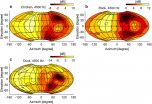(Press-News.org) DARIEN, IL - A new study shows that paid work time is the primary waking activity exchanged for sleep and suggests that chronic sleep loss potentially could be prevented by strategies that make work start times more flexible.
Results show that work is the dominant activity exchanged for less sleep across practically all sociodemographic categories. Compared to normal sleepers, short sleepers who reported sleeping 6 hours or less worked 1.55 more hours on weekdays and 1.86 more hours on weekends or holidays, and they started working earlier in the morning and stopped working later at night. The highest odds of being a short sleeper were found among adults working multiple jobs, who were 61 percent more likely than others to report sleeping 6 hours or less on weekdays. Respondents who were unemployed, retired or absent from the labor force also obtained significantly more sleep and were less likely to be short sleepers.
"The evidence that time spent working was the most prominent sleep thief was overwhelming," said lead author Dr. Mathias Basner, assistant professor of sleep and chronobiology in psychiatry at the University of Pennsylvania Perelman School of Medicine in Philadelphia.
Short sleepers also traveled more, started traveling earlier in the morning, and stopped later in the evening than normal sleepers. The travel pattern, with peaks at 7 a.m. and 5 p.m., strongly suggests that the majority of travel time is associated with commuting.
According to Basner, the results point to several possible solutions for workers' lack of sleep.
"Potential intervention strategies to decrease the prevalence of chronic sleep loss in the population include greater flexibility in morning work and class start times, reducing the prevalence of multiple jobs, and shortening morning and evening commute times," he said.
Results show that with every hour that work or educational training started later in the morning, sleep time increased by approximately 20 minutes. Respondents slept an average of only 6 hours when starting work before or at 6 a.m. and 7.29 hours when starting work between 9 a.m. and 10 a.m. Self-employed respondents with more flexible work times also obtained significantly more sleep than private sector employees and were 17 percent less likely to be a short sleeper.
Study results are published in the December issue of the journal Sleep.
"Getting at least seven hours of nightly sleep is essential to be at your mental, emotional and physical best for whatever you will pour yourself into, either at work or at home," said American Academy of Sleep Medicine President Dr. Timothy Morgenthaler, who was not involved in the study.
Basner and colleagues Andrea M. Spaeth, PhD, and David F. Dinges, PhD, analyzed responses from 124,517 Americans 15 years and older who completed the American Time Use Survey (ATUS) between 2003 and 2011. The computer-assisted telephone interview, which is sponsored by the U.S. Bureau of Labor Statistics and conducted annually by the U.S. Census Bureau, asks participants how they spent their time between 4 a.m. on the previous day and 4 a.m. on the interview day. Responses were combined into 40 distinct activities that captured 99.1 percent of the 24-hour day. Responses combined into the "sleeping" category included napping, waking up and dreaming.
According to the Centers for Disease Control and Prevention (CDC), 30 percent of employed U.S. adults typically sleep 6 hours or less in a 24-hour period, which represents approximately 40.6 million workers. The American Academy of Sleep Medicine recommends that adults get about 7 to 9 hours of nightly sleep for optimal health, productivity and daytime alertness.
INFORMATION:
The monthly, peer-reviewed, scientific journal Sleep is published online by the Associated Professional Sleep Societies LLC, a joint venture of the American Academy of Sleep Medicine and the Sleep Research Society. The AASM is a professional membership society that improves sleep health and promotes high quality patient centered care through advocacy, education, strategic research, and practice standards. A searchable directory of AASM accredited sleep centers is available at http://www.sleepeducation.org.
December 11, 2014 - Hospitals with robotic surgical systems are more likely to perform "nephron-sparing" partial nephrectomy--a recommended alternative to removal of the entire kidney--in patients with kidney cancer, reports a study in the December issue of Medical Care. The journal is published by Lippincott Williams & Wilkins, a part of Wolters Kluwer Health.
"Hospital acquisition of the surgical robot is associated with greater proportion of partial nephrectomy, an underutilized, guideline-encouraged procedure," write Dr Ganesh Sivarajan of New York University Langone ...
An interstellar mystery of why stars form has been solved thanks to the most realistic supercomputer simulations of galaxies yet made.
Theoretical astrophysicist Philip Hopkins of the California Institute of Technology (CalTech) led research that found that stellar activity -- like supernova explosions or even just starlight -- plays a big part in the formation of other stars and the growth of galaxies.
"Feedback from stars, the collective effects from supernovae, radiation, heating, pushing on gas, and stellar winds can regulate the growth of galaxies and explain why ...
Unlike mammals, birds have no external ears. The outer ears of mammals play an important function in that they help the animal identify sounds coming from different elevations. But birds are also able to perceive whether the source of a sound is above them, below them, or at the same level. Now a research team from Technische Universität München (TUM) has discovered how birds are able to localize these sounds, namely by utilizing their entire head. Their findings were published recently in the PLOS ONE journal.
It is springtime, and two blackbirds are having ...
NEW YORK, NY - Patients with operable kidney cancers were more likely to have a partial nephrectomy -- the recommended treatment for localized tumors -- when treated in hospitals that were early adopters of robotic surgery, according to a new study.
Researchers from NYU Langone Medical Center and elsewhere, publishing online December 11 in the journal Medical Care, report that by 2008, hospitals that had adopted robotic surgery at the start of the current century (between 2001 and 2004) performed partial nephrectomies in 38% of kidney cancer cases compared to late adopters ...
Novel research reveals that the risk of acute gout attacks is more than two times higher during the night or early morning hours than it is in the daytime. The study published in Arthritis & Rheumatology, a journal of the American College of Rheumatology (ACR), confirms that nocturnal attacks persist even among those who did not consume alcohol and had a low amount of purine intake during the 24 hours prior to the gout attack.
The body produces uric acid from the process of breaking down purines--natural substances in cells in the body and in most foods--with especially ...
Parkinson's disease sufferers have a different microbiota in their intestines than their healthy counterparts, according to a study conducted at the University of Helsinki and the Helsinki University Central Hospital (HUCH).
"Our most important observation was that patients with Parkinson's have much less bacteria from the Prevotellaceae family; unlike the control group, practically no one in the patient group had a large quantity of bacteria from this family," states DMSc Filip Scheperjans, neurologist at the HUCH Neurology Clinic.
The researchers have not yet ...
A team of researchers led by North Carolina State University has found that stacking materials that are only one atom thick can create semiconductor junctions that transfer charge efficiently, regardless of whether the crystalline structure of the materials is mismatched - lowering the manufacturing cost for a wide variety of semiconductor devices such as solar cells, lasers and LEDs.
"This work demonstrates that by stacking multiple two-dimensional (2-D) materials in random ways we can create semiconductor junctions that are as functional as those with perfect alignment" ...
Researchers have found new evidence that explains how some aspects of our personality may affect our health and wellbeing, supporting long-observed associations between aspects of human character, physical health and longevity.
A team of health psychologists at The University of Nottingham and the University of California in Los Angeles carried out a study to examine the relationship between certain personality traits and the expression of genes that can affect our health by controlling the activity of our immune systems.
The study did not find any results to support ...
Could there finally be tangible evidence for the existence of dark matter in the Universe? After sifting through reams of X-ray data, scientists in EPFL's Laboratory of Particle Physics and Cosmology (LPPC) and Leiden University believe they could have identified the signal of a particle of dark matter. This substance, which up to now has been purely hypothetical, is run by none of the standard models of physics other than through the gravitational force. Their research will be published next week in Physical Review Letters.
When physicists study the dynamics of galaxies ...
In the hunt for better knowledge on the aging process, researchers from Lund University have now enlisted the help of small birds. A new study investigates various factors which affect whether chicks are born with long or short chromosome ends, called telomeres.
The genetic make-up of our cells consists of genes lined up on chromosomes. The ends of the chromosomes are called telomeres, and they protect the chromosomes from sticking to each other. The longer the telomeres, the longer time the chromosomes are able to function. And conversely, the shorter these ends, ...


